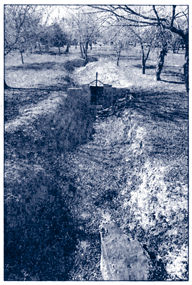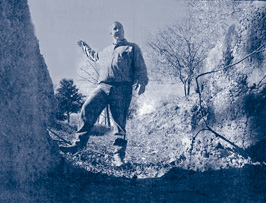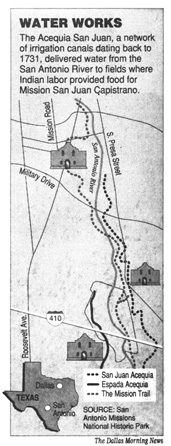 |
That's because it is.
More precisely, it is the Acequia San Juan, a seven-mile network of irrigation canals, sluice gates and dams dating back to 1731. It once delivered water from the San Antonio River to a sprawling array of fields where Indian labor provided food for Mission San Juan Capistrano.
After generations of neglect and urban development, the old irrigation canal will receive a face lift--a $92,000 project that will rebuild a damaged portion of the acequia. By next year, water will flow through The Ditch as its protectors lovingly call it, allowing volunteers to operatea small demonstration farm at the mission by 2001 that replicates 18th-century Spanish Colonial agricultural methods and crops.
"As simple as it appears to be, the acequia system is a pretty amazing feat of engineering," said James Oliver, landscape architect for the mission's historical park. "Using only hand tools, the Indians built a system of canals along the slope of the terrain that dropped only a inch or so in elevation over miles. They must have had a very keen sense of the landscape." Acequia San Juan is recognized by the state as holding the oldest water right in Texas. Along with the acequia serving Mission San Francisco de Espada farther down river, completed by 1745, it is the only remaining remnant of a Spanish colonial irrigation system that once ran 15 miles and watered more than 3,500 acres of mission farms. The chain of missions established along the San Antonio River sought to bring the small and diverse bands of hunter-gatherer tribes into Spanish society by teaching them the ways of Christ and citizenship. Indian workers known as labores built the missions and farmed the mission fields.
The mission priests never owned the land. They simply held it in trust for them [Indian workers] until they became gente de razon- people a of reason," said Rosalind Rock, National Park Service historian. "Farming
on the frontier, however, was a community affair. Land was parceled out to families, and everyone had to keep their section repaired and cleaned out. They had to agree on how the water would be allocated."
 |
"As simple as it appears to be, the acequia system is a pretty amazing feat of engineering," said landscape architect, James Oliver, standing in a section of the Acequia San Juan.

Farming
After secularization of the missions, descendants of the tribes and Hispanic colonists continued to farm small plots along the acequia, Dr. Rock said. "After Texas became a republic, Anglo settlers brought in a sense of land as an investment, not a heritage," Dr. Rock said. "Along the acequias at San Juan and Espada, however, the German, Polish and Italian settlers adopted the community standards of the descendants from the Spanish era." In 1900, the San Juan Irrigation Ditch Co. was formed as a cooperative, with landowners receiving one share of water per acre owned, according to Greg Rothe, executive director of the San Antonio River Authority. On the average, the 471 owners each received about one hour of water every 10 days. "The repairs will put the acequia back in service, and that's important from a state water rights standpoint," Mr. Rothe said. "Generally speaking, state law says that after 10 years of nonuse, the state could take action to cancel the water rights. This project will ensure that the users keep their rights."
Neglect
Years of neglect and urban development threatened to swallow Acequia San Juan, though it continued to provide water to local farmers' fields near the old mission until 1972, when flooding washed out a diversion dam on the river. Six years ago, a $6.5 million repair project by the San Antonio River Authority rebuilt areas where creeks discharged into the acequia. A new pump station drew water up into the acequia's starting point, and water flowed regularly through the entire acequia again. Last year, overflow from a creek that discharges into the acequia caused massive erosion of the canal walls, triggering a blowout. The river authority and National Park Service, which oversees the national historical park linking the five remaining missions, decided it was time to provide a permanent solution. The $92,000 repair cost of the acequia is being met by another cooperative effort. City Council member Debra Guerrero provided $40,000 from her district's discretionary fund. The San Antonio Conservation Society and Los Compadres de San Antonio Missions National Historic Park, a not-for-profit citizens group dedicated to preserving the city's Spanish Colonial mission heritage, came up with the rest.
Joint effort
"This has very much been a cooperative venture," Mr. Oliver said. "Without the help of the city, Los Compadres, the Conservation Society and the river authority's engineer, Dean Bayer, we wouldn't be this close to making it a reality." Although clogged by brush and bamboo in some spots, the acequia is about 3 feet deep and 4 feet wide as it meanders almost anonymously through the South Side neighborhood. "The San Juan Ditch Co. still exists, with the Mission Historical Park the primary shareholder, though some small farms adjacent to park holdings are also members,' Mr. Oliver said. "As such, they will be able to get water for free. All they have to do is clean out the portion of the ditch that goes to their land. It would be good to see life return to these farms." Water from the acequia will be the lifeblood of the 23-acre demonstration farm adjacent to Mission San Juan. There, volunteers will grow crops typical of the colonial era with tools and methods last used more than two centuries ago. Today, the field is a long, skinny rectangle that lies fallow. Ancient trees and a decrepit fence mark the boundaries that trace back to colonial times. "Our research shows that this is characteristic of the size of fields in the Spanish grants for the labores. It was considered the right size for one day's water from the acequias," Mr. Oliver said. "We are now searching out heritage seeds that will give us the same type of tomatoes, peppers, beans and other crops grown by the Indians for the mission. "Once repairs are in place, we'll be able to deliver water again as it has for almost three centuries. It's funny, but here we are, entering a new millennium, and we're still working on how to get water to run downhill."